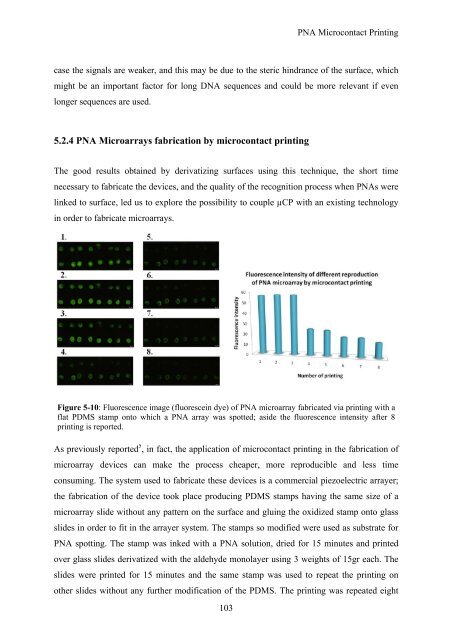View - DSpace UniPR
View - DSpace UniPR
View - DSpace UniPR
You also want an ePaper? Increase the reach of your titles
YUMPU automatically turns print PDFs into web optimized ePapers that Google loves.
PNA Microcontact Printing<br />
case the signals are weaker, and this may be due to the steric hindrance of the surface, which<br />
might be an important factor for long DNA sequences and could be more relevant if even<br />
longer sequences are used.<br />
5.2.4 PNA Microarrays fabrication by microcontact printing<br />
The good results obtained by derivatizing surfaces using this technique, the short time<br />
necessary to fabricate the devices, and the quality of the recognition process when PNAs were<br />
linked to surface, led us to explore the possibility to couple µCP with an existing technology<br />
in order to fabricate microarrays.<br />
Figure 5-10: Fluorescence image (fluorescein dye) of PNA microarray fabricated via printing with a<br />
flat PDMS stamp onto which a PNA array was spotted; aside the fluorescence intensity after 8<br />
printing is reported.<br />
As previously reported 5 , in fact, the application of microcontact printing in the fabrication of<br />
microarray devices can make the process cheaper, more reproducible and less time<br />
consuming. The system used to fabricate these devices is a commercial piezoelectric arrayer;<br />
the fabrication of the device took place producing PDMS stamps having the same size of a<br />
microarray slide without any pattern on the surface and gluing the oxidized stamp onto glass<br />
slides in order to fit in the arrayer system. The stamps so modified were used as substrate for<br />
PNA spotting. The stamp was inked with a PNA solution, dried for 15 minutes and printed<br />
over glass slides derivatized with the aldehyde monolayer using 3 weights of 15gr each. The<br />
slides were printed for 15 minutes and the same stamp was used to repeat the printing on<br />
other slides without any further modification of the PDMS. The printing was repeated eight<br />
103
















